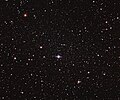Fișier:Carina Dwarf Galaxy.jpg

Mărimea acestei previzualizări: 719 × 600 pixeli. Alte rezoluții: 288 × 240 pixeli | 576 × 480 pixeli | 921 × 768 pixeli | 1.228 × 1.024 pixeli | 2.456 × 2.048 pixeli | 3.771 × 3.145 pixeli.
Mărește rezoluția imaginii (3.771 × 3.145 pixeli, mărime fișier: 5,64 MB, tip MIME: image/jpeg)
Istoricul fișierului
Apăsați pe Data și ora pentru a vedea versiunea trimisă atunci.
| Data și ora | Miniatură | Dimensiuni | Utilizator | Comentariu | |
|---|---|---|---|---|---|
| actuală | 24 februarie 2015 16:14 |  | 3.771x3.145 (5,64 MB) | FDMS4 | Reverted to version as of 14:03, 28 June 2011. |
| 24 februarie 2015 06:00 |  | 3.768x3.144 (5,78 MB) | SteinsplitterBot | Bot: Image rotated by 180° | |
| 28 iunie 2011 17:03 |  | 3.771x3.145 (5,64 MB) | Jmencisom |
Utilizarea fișierului
Următoarele pagini conțin această imagine:
Utilizarea globală a fișierului
Următoarele alte proiecte wiki folosesc acest fișier:
- Utilizare la af.wikipedia.org
- Utilizare la ar.wikipedia.org
- Utilizare la ast.wikipedia.org
- Utilizare la ca.wikipedia.org
- Utilizare la de.wikipedia.org
- Utilizare la el.wikipedia.org
- Utilizare la en.wikipedia.org
- Utilizare la es.wikipedia.org
- Utilizare la fi.wikipedia.org
- Utilizare la fr.wikipedia.org
- Utilizare la he.wikipedia.org
- Utilizare la id.wikipedia.org
- Utilizare la it.wikipedia.org
- Utilizare la ja.wikipedia.org
- Utilizare la ko.wikipedia.org
- Utilizare la mk.wikipedia.org
- Utilizare la nl.wikipedia.org
- Utilizare la no.wikipedia.org
- Utilizare la pl.wikipedia.org
- Utilizare la pt.wikipedia.org
- Utilizare la ru.wikipedia.org
- Utilizare la si.wikipedia.org
- Utilizare la sk.wikipedia.org
- Utilizare la tr.wikipedia.org
- Utilizare la uk.wikipedia.org
- Utilizare la vi.wikipedia.org
- Utilizare la www.wikidata.org